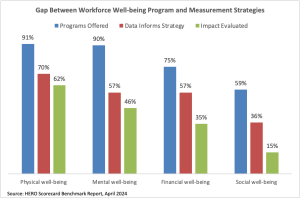It’s become a time-honored tradition for HERO members to gather in late Spring/early Summer for a Think Tank devoted to Measures That Matter for those advancing workforce health and well-being.
On May 22, 2024, more than 70 HERO members and a dozen Faculty experts convened for our Spring Think Tank to discuss measures of flourishing, with sessions that addressed:
- how to align business and sustainability with measures of flourishing;
- the critical role of employee exhaustion in burnout prevention and employee retention;
- the newly available NIOSH Worker Well-Being Questionnaire (WellBQ) and associated HERO Worker Well-being Clearinghouse;
- how to use artificial intelligence to identify actionable insights from employee sentiment data;
- the need to balance measures of flourishing with measures of loneliness and social isolation;
- new measures of thriving that include flow, wonder, and wisdom; and
- how to connect science about the above measurement tools with application and practice for employers.
Our focus on measures of flourishing was inspired by two studies that identified a potential gap between what’s going on programmatically as part of workforce well-being efforts and how those efforts are being measured or evaluated. A recent study by McKinsey researchers reported that leading employers have expanded their health and well-being (HWB) offerings to go beyond a focus on physical health to support mental, emotional, financial, social, and spiritual well-being. But the latest national benchmark data from the HERO Health and Well-being Best Practices Scorecard in Collaboration with Mercer© indicates employers’ measurement and evaluation strategies may not be keeping pace with the direction of their programs.

Physical and mental health programs are ubiquitous, with 90% of employers addressing these dimensions of well-being and 75% of employers offering financial well-being programs and resources. Yet, a little more than half say they use psychosocial/mental health or financial well-being data to inform their strategic planning for HWB. The gap for social well-being is even greater, with 59% of employers addressing social or relational well-being with their programs and 36% using data on social well-being to inform their approach. Even fewer employers are using data in these areas to measure and evaluate the effectiveness of their efforts, as only 46% include psychosocial/mental health data, 35% include financial well-being, and 15% include social well-being in their program evaluation activities.
Such gaps were addressed head-on in this May Think Tank, with a focus on practical measurement solutions that have been tested and validated in real world settings. Check out the Measures That Matter Proceedings for a review of the insights, tools, and resources we learned about from some of the world’s leading well-being researchers, psychometricians, and consultants. For a full list of our faculty bios, check out the full speaker brochure.
